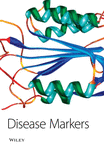Diagnostic and Prognostic Utility of PD-1 In B Cell Lymphomas
Abstract
Aims: Programmed death-1 (PD-1) is expressed by germinal center-associated helper T-cells and acts as a negative regulator of the immune system. PD-1 is encountered on tumor cells of angioimmunoblastic T-cell lymphoma and is a postulated diagnostic marker in chronic lymphocytic leukemia (CLL/SLL). Recent data suggest prognostic importance of PD-1 in follicular lymphoma (FL). We assessed the diagnostic potential and the prognostic importance of PD-1 in B-cell lymphomas.
Methods: Distribution of PD-1+ lymphocytes in B-cell lymphomas was studied on 403 cases. Correlation with known biologic and clinical key data was performed. Prognostic cut-off scores were determined by receiver operating curve analysis. Results: PD-1+ tumor-infiltrating lymphocytes were numerous in extranodal marginal zone lymphomas and FL. Their amount decreased from FL grade 1 to grade 3 and to FL with transformation to diffuse large B-cell lymphoma. An increased amount of PD-1 tumor-infiltrating lymphocytes above the prognostic cut-off score (> 2.8%) was a positive prognostic factor of disease-specific survival (DSS) in FL-patients. Five percent of the studied 66 CLL/SLL cases showed unequivocal PD-1 positivity of neoplastic cells.
Conclusions: Increased number of PD-1+ tumor-infiltrating lymphocytes is associated with significantly improved DSS in FL and may be useful to predict its heterogeneous clinical behavior. PD-1 has probably limited diagnostic value for primary histopathological CLL/SLL diagnostics.




